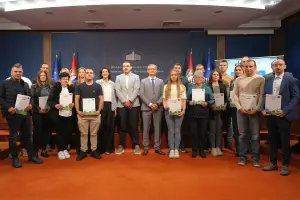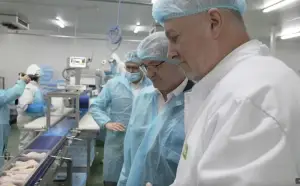- Serbia
Get to know Serbia
- Citizens
Culture and science
Health services
Pension and disability insurance
- Business
Employment
Economy
- Media
- Government
- Contact
Keep in touch
Contact form
Back
Keepin touch
Whether you have a question, comment, suggestion or any problem in the purview of the government, send us your message and we will try to respond as soon as possible. If your problem is not in our purview, we will forward your message to the relevant institution.
Q:
A:
Grey economy accounts for 9 percent of GDP
Belgrade,
15 September 2004
According to a survey of annual balance sheets of Serbian companies whose combined output accounts for one-half of the country’s gross domestic product (GDP), the grey economy accounts for approximately 9 percent of GDP, the latest figures released by the Serbian Statistical Office have shown.
Assistant Director of the Statistical Office Andra Milojic told a press conference held at the Serbian government that the 2001 and 2002 surveys showed that companies tend to show lower income than is really in their annual balance sheets. Therefore, the next survey will include many illegal activities that have not been included so far. He added that the previous surveys did not include illegal activities such as prostitution, drug trafficking, or copyright and piracy violations.
According to Milojic's estimates, after including all grey economy activities in the survey, the grey economy will account for 20 to 25 percent of GDP. He explained that this enhanced number ranges from between 15 and 20 percent in all EU candidate countries.
The project analysing the grey economy will be under way by 2006. Serbia will be included in the analysis for first time this year, as part of a study of western Balkan countries, said the Assistant Minister of the Serbian Statistical Office.
In the processing industry, the grey economy made up for 4.15 percent in 2001 and 3.5 in 2002, and in the transport 1 percent and 1.2 percent respectively.
In the wholesale and retail industry, the grey economy accounted for 0.85 percent in 2001 and 0.96 percent in 2002, Milojc added.
This compares with European Union countries, where the grey economy share ranges from one to four percent at most, except for Italy, where that number stands at 15 percent.
Milojic said that that the presence of illegal economy will be reduced with better functioning of the tax system.
Assistant Director of the Serbian Statistical Office Slavko Kapuran said that citizens of Serbia spend more than 50 percent of income on food and drink (both alcoholic and soft), according to a survey made in 2003, on a sample of 4,000 households.
According to Milojic's estimates, after including all grey economy activities in the survey, the grey economy will account for 20 to 25 percent of GDP. He explained that this enhanced number ranges from between 15 and 20 percent in all EU candidate countries.
The project analysing the grey economy will be under way by 2006. Serbia will be included in the analysis for first time this year, as part of a study of western Balkan countries, said the Assistant Minister of the Serbian Statistical Office.
In the processing industry, the grey economy made up for 4.15 percent in 2001 and 3.5 in 2002, and in the transport 1 percent and 1.2 percent respectively.
In the wholesale and retail industry, the grey economy accounted for 0.85 percent in 2001 and 0.96 percent in 2002, Milojc added.
This compares with European Union countries, where the grey economy share ranges from one to four percent at most, except for Italy, where that number stands at 15 percent.
Milojic said that that the presence of illegal economy will be reduced with better functioning of the tax system.
Assistant Director of the Serbian Statistical Office Slavko Kapuran said that citizens of Serbia spend more than 50 percent of income on food and drink (both alcoholic and soft), according to a survey made in 2003, on a sample of 4,000 households.
-
 Belgrade, 27 October 2025
Belgrade, 27 October 2025Construction of Selova dam of vital importance for southeast Serbia
-
 Belgrade, 22 October 2025
Belgrade, 22 October 2025First 19 resolutions awarded under IPARD III for procurement of new tractors
-
 Šid, 21 October 2025
Šid, 21 October 2025Superior Foods example of successful Serbia-Hungary cooperation
-
 Belgrade/Washington, 17 October 2025
Belgrade/Washington, 17 October 2025Confirmation of Serbia’s position as attractive investment destination
-
 Belgrade/Washington, 16 October 2025
Belgrade/Washington, 16 October 2025Serbian economy maintains stability amid global challenges
-
 Sombor, 14 October 2025
Sombor, 14 October 2025Agriculture one of major pillars of bilateral cooperation with Italy
-
 Belgrade, 13 October 2025
Belgrade, 13 October 2025First IPARD III resolutions on support to farmers presented
-
 Belgrade, 21 September 2025
Belgrade, 21 September 2025Solution for legalisation of 4.8 million properties by year’s end
-
 Belgrade, 19 September 2025
Belgrade, 19 September 2025Strong potential for Italian investments in Serbia’s processing sector
-
 Belgrade, 17 September 2025
Belgrade, 17 September 2025Serbia committed to building strong economic ties with Russia
